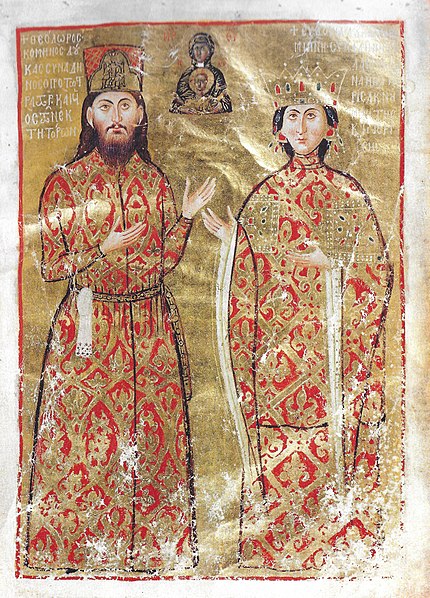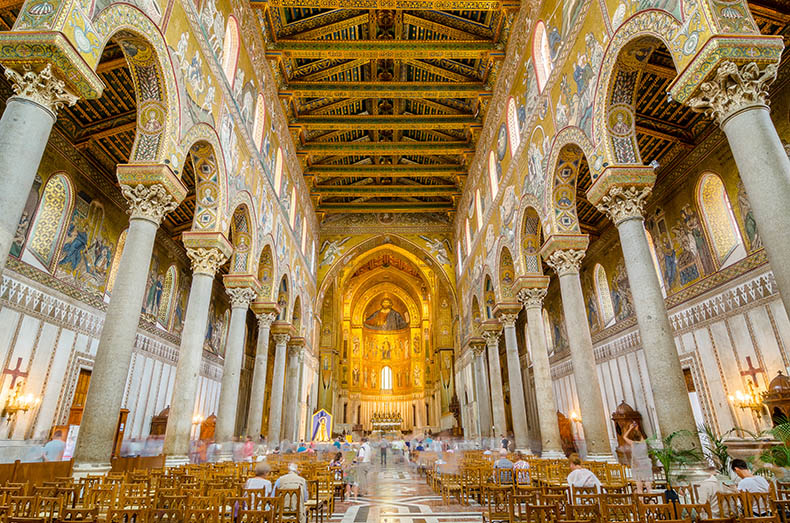

Manuel I Komnenus - birth of Alexios II wedding of Daughter Maria
From O City of Byzantium by Niketas Choniates
Since the empress was already in travail and about to give birth, the Purple Bedchamber was swept clean and meticulously prepared for the childbirth and the mother's reception. When the labor pains became acute, the parturient empress entered the Purple Bedchamber. The sight of the emperor, who was in attendance and anxious for his wife, eased her pangs; even more, he cast frequent glances at the stargazer, the gaper at heavenly signs. Since it was a male child that issued forth from the womb [14 September 1169 (1168?)], and the astrologer's art predicted that he should be blessed, a child of destiny, and successor to his father's throne, prayers of thanksgiving were offered up to God, and everyone applauded and rejoiced.
Celebrating the child's birthday and name-giving [22 September], Manuel, as is the custom among the Roman emperors, regaled the City's residents and named his son Alexios, choosing this name neither impulsively nor in honor of the grandfather's name, but taking heed of the oracular utterance in answer to the question: "How long shall the dynasty of Alexios Komnenos reign?" The oracular response was aima [blood]; if divided into letters and recounted in their order, the alpha clearly designated Alexios, the iota John [Ioannes], and the next two letters Manuel and his successor to the throne.
 As the boy increased in stature and shot up like a flourishing and luxuriant young plant, the emperor had another purpose to accomplish. He transferred to his son the oaths of allegiance that had earlier been pledged to his daughter Maria and her betrothed, the Hungarian Alexios [24 March 1171]. The emperor, his son, and those who were to pledge their oaths of allegiance to the latter entered the great and celebrated Church of the Mother of God in Blachernai. Having transmitted the dominion to the offspring of his loins by this ceremony of oath-taking, shortly thereafter he separated his daughter from Alexios and plighted his wife's sister,"' who had recently set out from Antioch with Baldwin, as his wife..
As the boy increased in stature and shot up like a flourishing and luxuriant young plant, the emperor had another purpose to accomplish. He transferred to his son the oaths of allegiance that had earlier been pledged to his daughter Maria and her betrothed, the Hungarian Alexios [24 March 1171]. The emperor, his son, and those who were to pledge their oaths of allegiance to the latter entered the great and celebrated Church of the Mother of God in Blachernai. Having transmitted the dominion to the offspring of his loins by this ceremony of oath-taking, shortly thereafter he separated his daughter from Alexios and plighted his wife's sister,"' who had recently set out from Antioch with Baldwin, as his wife..
The emperor once again carefully searched for a husband for his daughter. Making light of Roman nobles who were candidates for marriage, he carefully selected those dynasts of nations who were unmarried or those with sons who, following the death of their parents, would succeed to the paternal throne. The first place fell to William, king of Sicily. One envoy after another was sent to him, while he dispatched envoys back again to negotiate the marriage contract; the embassies alternated, and the preliminary wedding deliberations were drawn out in idle chatter. When these oscillated like a scale rising and falling and were frequently altered and modified, the emperor finally changed his mind, deeming a marriage with the king of Sicily to be disadvantageous to the Romans.
The maiden, a princess wooed by many, was like Agamemnon's daughter Electra raving long in the palace and, stately as a white poplar wet with dew, longing for the marriage bed. Later, after the emperor had given the matter much thought, she became the consort of one of the sons [Renier] of the Count of Montferrat [February 1180 (1179?)], who was fair of face and pleasant to look upon; his well-groomed hair shone like the sun and he was too young to grow a beard, while she had passed her thirtieth year and was as strong as a man. 
<




 click here for icons of christ
click here for icons of christ click here for icons of the theotokos
click here for icons of the theotokos click here for icons of angels
click here for icons of angels click here for icons of saints
click here for icons of saints








